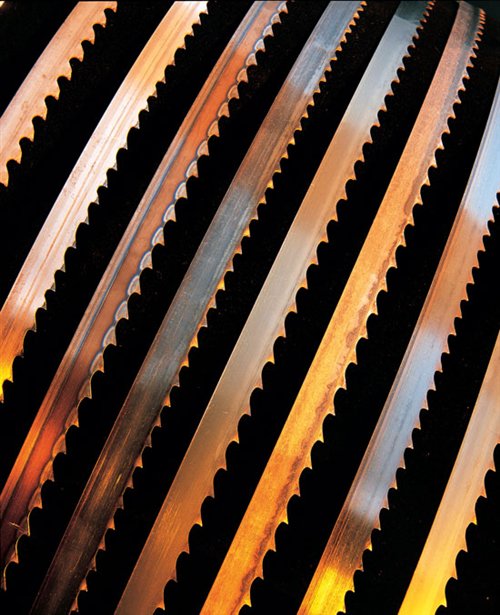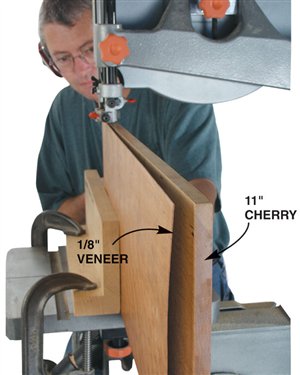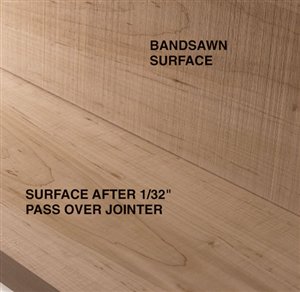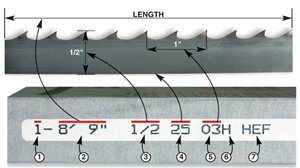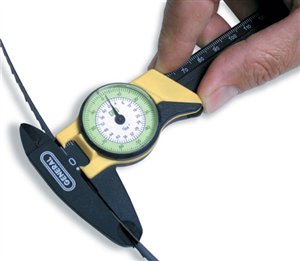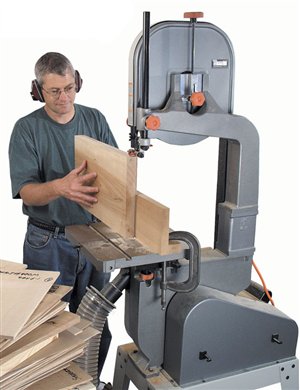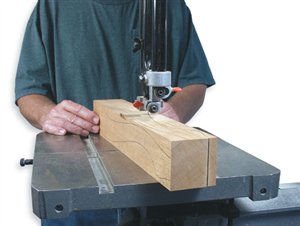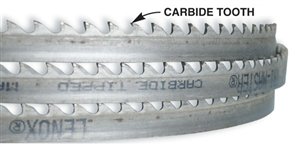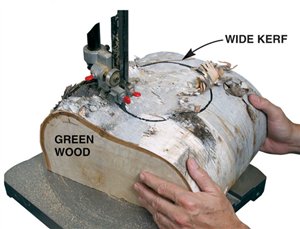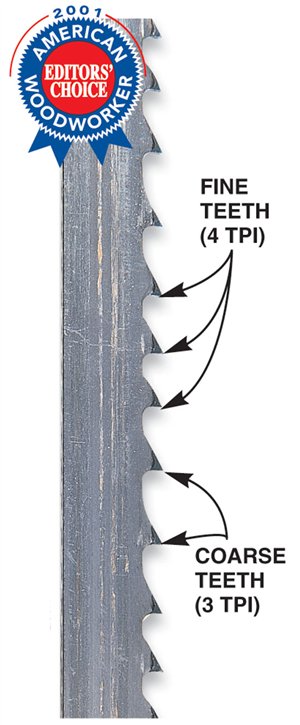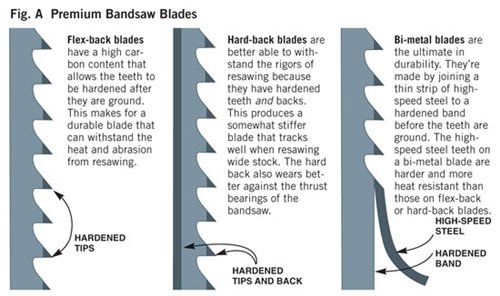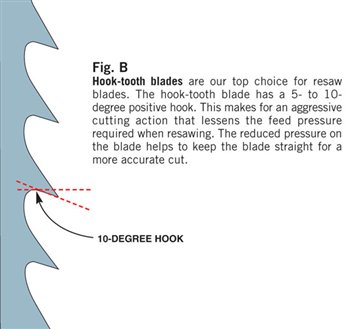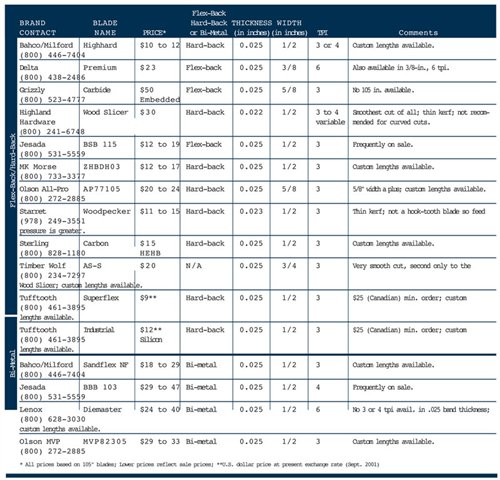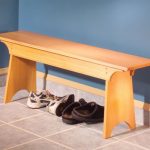We may receive a commission when you use our affiliate links. However, this does not impact our recommendations.
Straight-cutting blades that won't let you down.
by Dave Munkittrick
A bandsaw is an amazing machine. It’s capable of making extremely precise cuts; from slicing sheets of thin veneer to cutting intricate curves. Yet many of us think of our bandsaws as being for rough work only. Why? Probably because our first attempts at precision work, like resawing, were thwarted by ordinary blades. It’s probably not your saw or your technique, it’s your blade that’s the problem. Take a premium bandsaw blade for a spin and you’ll be amazed at the difference.
|
Most bandsaws come with ordinary carbon-steel or spring-steel blades. These blades are okay for general bandsaw work but the untreated metal is not designed to withstand the rigors of resawing. Resawing wood is essentially rip cutting a board across its width (Photo 1). There’s a tremendous amount of wood to remove and the heat and abrasion caused by resawing will quickly wear out an ordinary blade.
Premium blades have hardened teeth, and they far outlast ordinary blades. There are three basic types of premium blades; flex-back, hard-back and bi-metal (see Fig. A, below).
Shopping for bandsaw blades is like trying to pick a long distance phone company. There are so many variations and confusing terminology its hard to know what you’re getting. For starters, you’ve got silicon steel, tungsten steel, carbon manganese spring steel, or, my personal favorite, cobalt/molybdenum high-speed steel.
The real question is “How do the blades perform?” That’s what we looked at in this test. The Test
Resawing is by far the most demanding job asked of a bandsaw blade. A straight, even cut that doesn’t require a great deal of clean up was our gold standard. We tested all the premium resaw blades we could find that can safely be used on a 14-in. bandsaw (see “Blade Thickness,” below, for more on this topic). The test itself was straightforward. We cut 1/8-in.-thick veneer from 8 in. x 24-in. slabs of 8/4 maple, oak and pine. After each cut we ran the cut face of the slab over a jointer set to take a 1/32-in. cut. If the saw marks cleaned up in a single pass (Photo 2), the blade was declared a winner and was included in our chart below. If at first the blade did not succeed, we tried again; adjusting the tension or altering the feed rate. Results
If you only resaw on occasion and want a blade primarily for general-purpose work, a flex-back or hard-back blade is your best choice. For hard-core resawing, the hard-back or bi-metal hook-tooth blades with three tpi did the best overall job. A bi-metal blade is considerably more expensive but it will far outlast a hard-back blade because of the extra-hard, high-speed steel used to form the teeth (Fig. A, below). Blade Features
Let’s look at the features that make up a premium bandsaw blade (Photo 3). Blade Thickness
We recommend a maximum blade thickness of .025-in. for use on a 14-in. bandsaw (Photo 4). Most 14-in. saws are just not built to properly tension a blade thicker than .025 in. and the thicker the blade the more tension it takes to make it work properly. Also, forcing a thicker blade around a 14-in. wheel at 35 mph can lead to metal fatigue and possible breakage. You can demonstrate this yourself. Take a length of wire from a clothes hanger and bend it back and forth several times. It won’t be long before the metal fatigues and breaks in two. Bandsaw blades are no different. Blade Width
For resawing you want to use the widest blade your saw can handle. A wide blade resists bending as stock is pushed into it. This is commonly referred to as “beam strength.” Another advantage to wide blades is their ability to dissipate heat. The extra metal acts as a heat sink, drawing excess heat away from the teeth. Note: Most 14-in. bandsaws can take a 3/4-in. blade, but be careful! Most 3/4-in. blades are also too thick (.032-in. or greater) for your saw. So, it’s the thickness of the blade that limits how wide a blade you can put on a 14-in. saw. For the most part, you are limited to 1/2-in.-wide blades in order to stay within the .025-in. thickness limitation. Some notable exceptions are Olson’s All-Pro (AP77105) and Grizzly’s Carbide Embedded blade, which are 5/8-in. wide. The Timber Wolf AS-S series is 3/4-in. wide but only .025-in. thick. Teeth Per Inch (tpi)
Use a three tpi blade for resawing on a 14-in. bandsaw. The larger teeth on a three tpi blade have deeper gullets that help carry the sawdust through the cut without binding. A four or a six tpi will give you a slightly smoother cut, but you’ll have to slow your feed rate down on wide stock. Tooth Form
Tooth form describes the shape of the tooth. A hook tooth is the best tooth form for resawing. The hook angle cuts aggressively and has a self-feeding action that reduces feed pressure (Fig. B, below). Durability
If you do a lot of resawing, you may find bi-metal blades worth the extra money because the extra-hard teeth are designed to outlast hardened carbon-steel blades. Our Recommendations
There were two blades we considered to be firsts among equals. Highland Hardware’s Wood Slicer blade and the Timber Wolf AS-S gave the smoothest cuts of all the blades we tested.
We didn’t choose a Best Buy because there are so many good blades at the lower end of the price range (less than $15).
|
Photo 1: Resawing wood is tough on bandsaw blades. Only premium bandsaw blades with hardened teeth can hold their edge and produce straight, smooth cuts in wide stock like this.
TIP: Keep a new premium resaw blade on hand to use when maximum performance is critical. Like that best suit in your closet, use it only for special occasions.
Photo 2: We resawed 1/8-in. veneer from 8/4 slabs of maple to test the blades. The sawn surface of the slab was then passed over a jointer set for a 1/32-in.-deep cut. If a single pass cleaned up all the saw marks, the blade made it onto our chart below.
Photo 3: The features we liked for resaw bandsaw blades are listed right on the box. 1. Quantity of blades. 2. Blade length. 3. Blade width. 4. Blade thickness in thousandths of an inch. 5. Number of teeth per inch (tpi). 6. Tooth form (H = hook tooth). 7. Blade type (HEF = hard-edge flex-back).
Photo 4: A .025-in.-thick blade is best for 14-in. bandsaws. Thicker blades can’t be tensioned properly on a small saw and may develop metal fatigue from bending stresses caused by the small-diameter wheels.
Photo 5: Increased durability is the big benefit you get from bi-metal blades. They cost twice as much, but will likely last two to three times longer than flex-back or hard-back blades.
Tip: Hang onto those resaw blades that no longer perform at their peak. They still work great for general-purpose cutting.
Carbide blades are the ultimate in durability. Production shops and people who cut a lot of exotic hardwood that contains abrasive chemical extractives love these long-lasting blades.The Lennox carbide blade we tried made beautifully smooth cuts. But, the $120 price tag keeps it out of reach for most shop owners.
The Timber Wolf 1203AS is a specially designed wet resaw blade. The extra-wide kerf is designed to help clear the moist, stringy fibers in green wood. The blade is thicker than we recommend (.030-in.) for a 14-in. saw, but the Timber Wolf has a blade body made of flexible silicon steel that can handle the small-diameter wheels without fatigue. If you cut a lot of green wood, you may want to give one of these blades a spin. |
|
Highland Hardware’s Wood Slicer is a unique blade among our picks. It made extra-smooth cuts with less noise. Part of the reason is the Wood Slicer’s unique variable tpi design. The tpi varies from three to four, which helps reduce vibration and produces a smoother cut. Reduced vibration also results in reduced noise. Most bandsaw blades sound like a catfight as they’re cutting through wide stock. The Wood Slicer is noticeably quieter.
The Wood Slicer also has the thinnest blade of the bunch at .020-in. thick, with an exceptionally narrow kerf (about 1/32 in.). The thin kerf results in increased yield with less horsepower required from your saw (1/2-hp saw owners, take note). On the downside, the kerf is so narrow that the blade will not cut curves very well. Once the Wood Slicer has lost its edge, it can’t be retired to general-purpose duty as readily as the other blades.
For icing on the cake, the back of the Wood Slicer blade is rounded and polished at the factory to eliminate any source for fatigue cracks in the body.
|
|
|
Suffolk Machinery’s Timber Wolf AS-Sis specifically designed for straight-line slicing veneer. It’s the only blade that’s a full 3/4-in. wide but only .025 thick. This blade was designed for instrument makers who make a living slicing up blocks of wood that are worth their weight in gold. They can’t afford any cutting problems and demand the smoothest possible cuts.
|
|
This story originally appeared in American Woodworker December 2001, issue #91.
Source information may have changed since the original publication date.
Here are some supplies and tools we find essential in our everyday work around the shop. We may receive a commission from sales referred by our links; however, we have carefully selected these products for their usefulness and quality.



